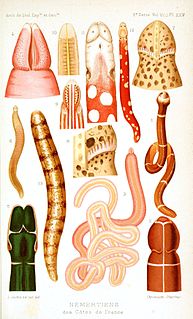
Skin is the soft outer tissue covering of vertebrates with three main functions: protection, regulation, and sensation.

In biology, tissue is a cellular organisational level between cells and a complete organ. A tissue is an ensemble of similar cells and their extracellular matrix from the same origin that together carry out a specific function. Organs are then formed by the functional grouping together of multiple tissues.

Mucus is a polymer. It is a slippery aqueous secretion produced by, and covering, mucous membranes. It is typically produced from cells found in mucous glands, although it may also originate from mixed glands, which contain both serous and mucous cells. It is a viscous colloid containing inorganic salts, antiseptic enzymes, immunoglobulins, and glycoproteins such as lactoferrin and mucins, which are produced by goblet cells in the mucous membranes and submucosal glands. Mucus serves to protect epithelial cells in the respiratory, gastrointestinal, urogenital, visual, and auditory systems; the epidermis in amphibians; and the gills in fish, against infectious agents such as fungi, bacteria and viruses. Most of the mucus produced is in the gastrointestinal tract.

The Turbellaria are one of the traditional sub-divisions of the phylum Platyhelminthes (flatworms), and include all the sub-groups that are not exclusively parasitic. There are about 4,500 species, which range from 1 mm (0.039 in) to large freshwater forms more than 500 mm (20 in) long or terrestrial species like Bipalium kewense which can reach 600 mm (24 in) in length. All the larger forms are flat with ribbon-like or leaf-like shapes, since their lack of respiratory and circulatory systems means that they have to rely on diffusion for internal transport of metabolites. However, many of the smaller forms are round in cross section. Most are predators, and all live in water or in moist terrestrial environments. Most forms reproduce sexually and with few exceptions all are simultaneous hermaphrodites.

The bootlace worm is one of the longest known animals, with specimens up to 55 m (180 ft) long being reported. Its mucus is highly toxic.

Goblet cells are simple columnar epithelial cells that secrete gel-forming mucins, like mucin MUC5AC. The goblet cells mainly use the merocrine method of secretion, secreting vesicles into a duct, but may use apocrine methods, budding off their secretions, when under stress. The term goblet refers to the cell's goblet-like shape. The apical portion is shaped like a cup, as it is distended by abundant mucus laden granules; its basal portion lacks these granules and is shaped like a stem.

Anopla has long been used as name for a class of marine worms of the phylum Nemertea, characterized by the absence of stylets on the proboscis, the mouth being below or behind the brain, and by having separate openings for the mouth and proboscis. The other long used class of Nemertea are the Enopla. Although Anopla is a paraphyletic grouping, it is used in almost all Scientific classifications. Anopla is divided into two orders: Palaeonemertea and Heteronemertea.

Palaeonemertea is an order of primitive nemertean worm. It may be para- or polyphyletic, consisting of three to five clades and totalling about 100 species.

Heteronemertea is a monophyletic order of about 500 species of nemertean worm. It contains genera such as Lineus and Cerebratulus, and includes the largest and most muscular nemerteans.

Not to be confused with Enoplea, a clade of nematodes or roundworms.

Tricladida (triclads) is an order of free-living flatworms. They are also known as planarians, although this common name is also used for a wide number of free-living platyhelminthes.

Geoplanidae is a family of flatworms known commonly as land planarians or land flatworms.

Mollusca is the second largest phylum of invertebrate animals. The members are known as molluscs or mollusks. Around 85,000 extant species of molluscs are recognized. The number of fossil species is estimated between 60,000 and 100,000 additional species.
In zoology, the epidermis is an epithelium that covers the body of a eumetazoan. Eumetazoa have a cavity lined with a similar epithelium, the gastrodermis, which forms a boundary with the epidermis at the mouth.

Kenkiidae is a family of freshwater triclads. Their species can be found sporadically in caves, groundwater, and deep lakes in Central Asia, Far East and North America.

The annelids, also known as the ringed worms or segmented worms, are a large phylum, with over 22,000 extant species including ragworms, earthworms, and leeches. The species exist in and have adapted to various ecologies – some in marine environments as distinct as tidal zones and hydrothermal vents, others in fresh water, and yet others in moist terrestrial environments.
Rhabditophora is a class of flatworms. It includes all parasitic flatworms and most free-living species that were previously grouped in the now obsolete class Turbellaria. Therefore, it contains the majority of species in the phylum Platyhelminthes, excluding only the catenulids, to which they appear to be the sister group.

Proseriata is an order of free-living flatworms in the class Rhabditophora with over 400 species described worldwide.
Macrostomum rostratum is a free-living, hermaphroditic flatworm in the family Macrostomidae, found in freshwater and brackish environments.















